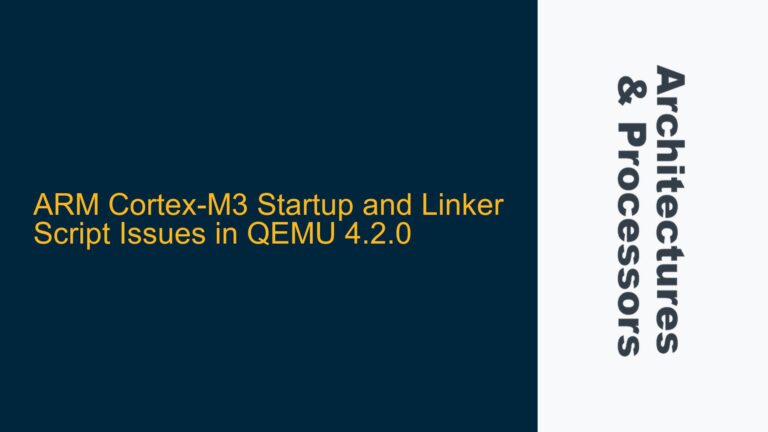ARM AXI4 Protocol: WVALID and AWREADY Timing Dependencies
The ARM AXI4 protocol is a widely used on-chip communication standard for high-performance embedded systems. It defines a set of rules and signaling mechanisms for data transfers between managers (masters) and subordinates (slaves). One of the critical aspects of the AXI4 protocol is the timing relationship between the WVALID and AWREADY signals during write transactions. Misunderstanding or misimplementing these dependencies can lead to subtle bugs, performance bottlenecks, or even system failures.
The WVALID signal is asserted by the manager to indicate that the write data is valid and ready to be transferred. The AWREADY signal is asserted by the subordinate to indicate that it is ready to accept the write address. According to the AXI4 specification (IHI0022K), the manager must not wait for the subordinate to assert AWREADY or WREADY before asserting AWVALID or WVALID. However, the subordinate can wait for AWVALID or WVALID, or both, before asserting AWREADY.
This creates a potential point of confusion: if the manager is not allowed to wait for AWREADY before asserting WVALID, how should the timing of these signals be managed to ensure correct operation? This post will delve into the nuances of this issue, explore possible causes of misinterpretation, and provide detailed troubleshooting steps and solutions.
Misinterpretation of AXI4 Specification and Timing Diagrams
The core issue arises from a misinterpretation of the AXI4 specification and its accompanying timing diagrams. The specification states that the manager must not wait for AWREADY or WREADY before asserting AWVALID or WVALID. However, the timing diagram provided in the specification shows a scenario where WVALID is asserted after AWREADY is asserted, which can lead to the assumption that there is a dependency between these signals.
This misinterpretation is further compounded by the fact that the timing diagram is not explicitly labeled to indicate whether the observed sequence is coincidental or intentional. In reality, the timing diagram is merely illustrating one possible sequence of events and does not imply a strict dependency between WVALID and AWREADY.
The confusion stems from the following key points:
-
Manager Independence: The manager is required to assert
AWVALIDandWVALIDindependently of the subordinate’s readiness signals (AWREADYandWREADY). This ensures that the manager can initiate transactions without being blocked by the subordinate’s state. -
Subordinate Flexibility: The subordinate has the flexibility to wait for
AWVALIDorWVALID, or both, before assertingAWREADY. This allows the subordinate to optimize its internal operations based on the availability of address and data. -
Timing Diagram Ambiguity: The timing diagram does not explicitly state whether the observed sequence of
WVALIDassertion afterAWREADYis a coincidence or a dependency. This ambiguity can lead to incorrect assumptions about the protocol’s requirements.
To resolve this confusion, it is essential to revisit the AXI4 specification and carefully analyze the signaling requirements and timing relationships.
Implementing Correct AXI4 Write Transaction Signaling
To ensure correct implementation of AXI4 write transactions, it is crucial to adhere to the protocol’s signaling requirements and avoid introducing unintended dependencies between WVALID and AWREADY. The following steps outline the correct approach to managing these signals:
-
Manager Signaling Requirements:
- The manager must assert
AWVALIDandWVALIDindependently of the subordinate’s readiness signals. This means that the manager should not wait forAWREADYorWREADYbefore assertingAWVALIDorWVALID. - The manager should ensure that
AWVALIDandWVALIDare asserted as soon as the corresponding address and data are available, regardless of the subordinate’s state.
- The manager must assert
-
Subordinate Signaling Requirements:
- The subordinate can wait for
AWVALIDorWVALID, or both, before assertingAWREADY. This allows the subordinate to optimize its internal operations based on the availability of address and data. - The subordinate should assert
AWREADYonly when it is ready to accept the write address and data. This ensures that the subordinate does not become a bottleneck in the transaction.
- The subordinate can wait for
-
Timing Considerations:
- The timing diagram provided in the AXI4 specification should be interpreted as one possible sequence of events and not as a strict dependency between
WVALIDandAWREADY. - Designers should focus on the protocol’s signaling requirements rather than relying solely on timing diagrams to infer dependencies.
- The timing diagram provided in the AXI4 specification should be interpreted as one possible sequence of events and not as a strict dependency between
-
Verification and Testing:
- Implement comprehensive verification and testing procedures to ensure that the manager and subordinate adhere to the AXI4 signaling requirements.
- Use simulation tools to model the behavior of the manager and subordinate and verify that the signaling sequences comply with the protocol’s requirements.
- Perform corner-case testing to ensure that the system operates correctly under all possible timing conditions.
-
Debugging and Troubleshooting:
- If issues arise during implementation, use debugging tools to capture and analyze the signaling sequences between the manager and subordinate.
- Check for unintended dependencies between
WVALIDandAWREADYand ensure that the manager and subordinate adhere to the protocol’s signaling requirements. - Review the timing diagrams and specification to identify any misinterpretations or ambiguities that may have led to the issue.
By following these steps, designers can ensure that their AXI4 implementations adhere to the protocol’s requirements and avoid the pitfalls associated with misinterpreted timing dependencies.
Advanced Considerations and Best Practices
To further enhance the robustness and performance of AXI4-based systems, consider the following advanced considerations and best practices:
-
Concurrency and Pipelining:
- Leverage the AXI4 protocol’s support for concurrent and pipelined transactions to maximize system throughput.
- Ensure that the manager and subordinate can handle multiple outstanding transactions without introducing unnecessary delays or dependencies.
-
Signal Integrity and Timing Margins:
- Pay close attention to signal integrity and timing margins to ensure reliable operation at high clock frequencies.
- Use proper synchronization techniques to handle cross-clock domain interactions and avoid metastability issues.
-
Performance Optimization:
- Optimize the manager and subordinate implementations to minimize latency and maximize data transfer efficiency.
- Use performance profiling tools to identify and address bottlenecks in the system.
-
Compliance with AXI4 Specification:
- Regularly review the AXI4 specification to stay updated on any changes or clarifications.
- Ensure that all implementations comply with the latest version of the specification to avoid compatibility issues.
-
Documentation and Knowledge Sharing:
- Maintain detailed documentation of the AXI4 implementation, including signaling sequences, timing diagrams, and verification procedures.
- Share knowledge and best practices with the team to ensure consistent and high-quality implementations across the organization.
By incorporating these advanced considerations and best practices, designers can create robust, high-performance AXI4-based systems that meet the demands of modern embedded applications.
In conclusion, the confusion surrounding the timing dependencies between WVALID and AWREADY in the AXI4 protocol stems from a misinterpretation of the specification and timing diagrams. By carefully adhering to the protocol’s signaling requirements, implementing comprehensive verification and testing procedures, and following advanced best practices, designers can ensure correct and efficient operation of their AXI4-based systems. This detailed guide provides the necessary insights and steps to resolve the issue and achieve optimal performance in ARM-based embedded systems.






